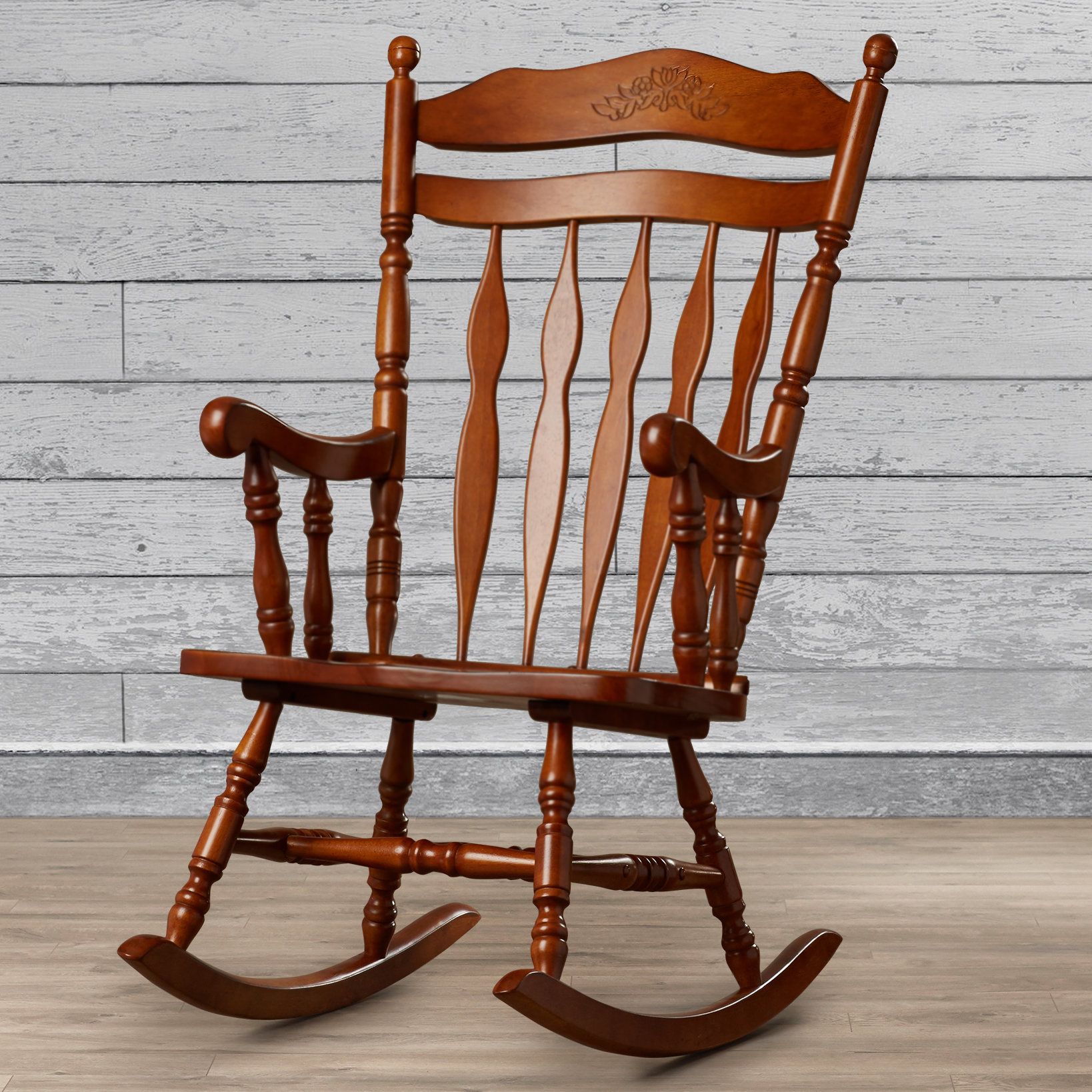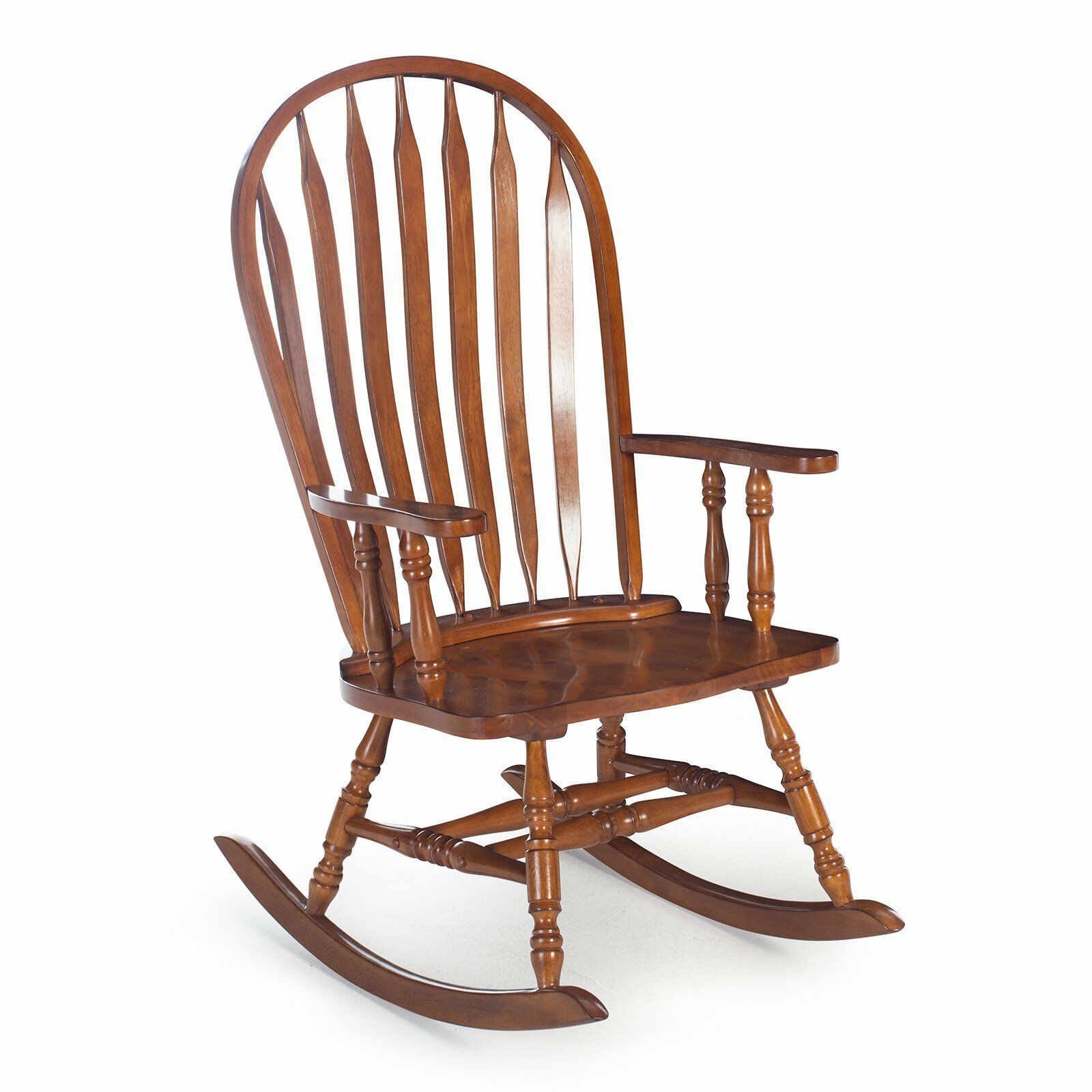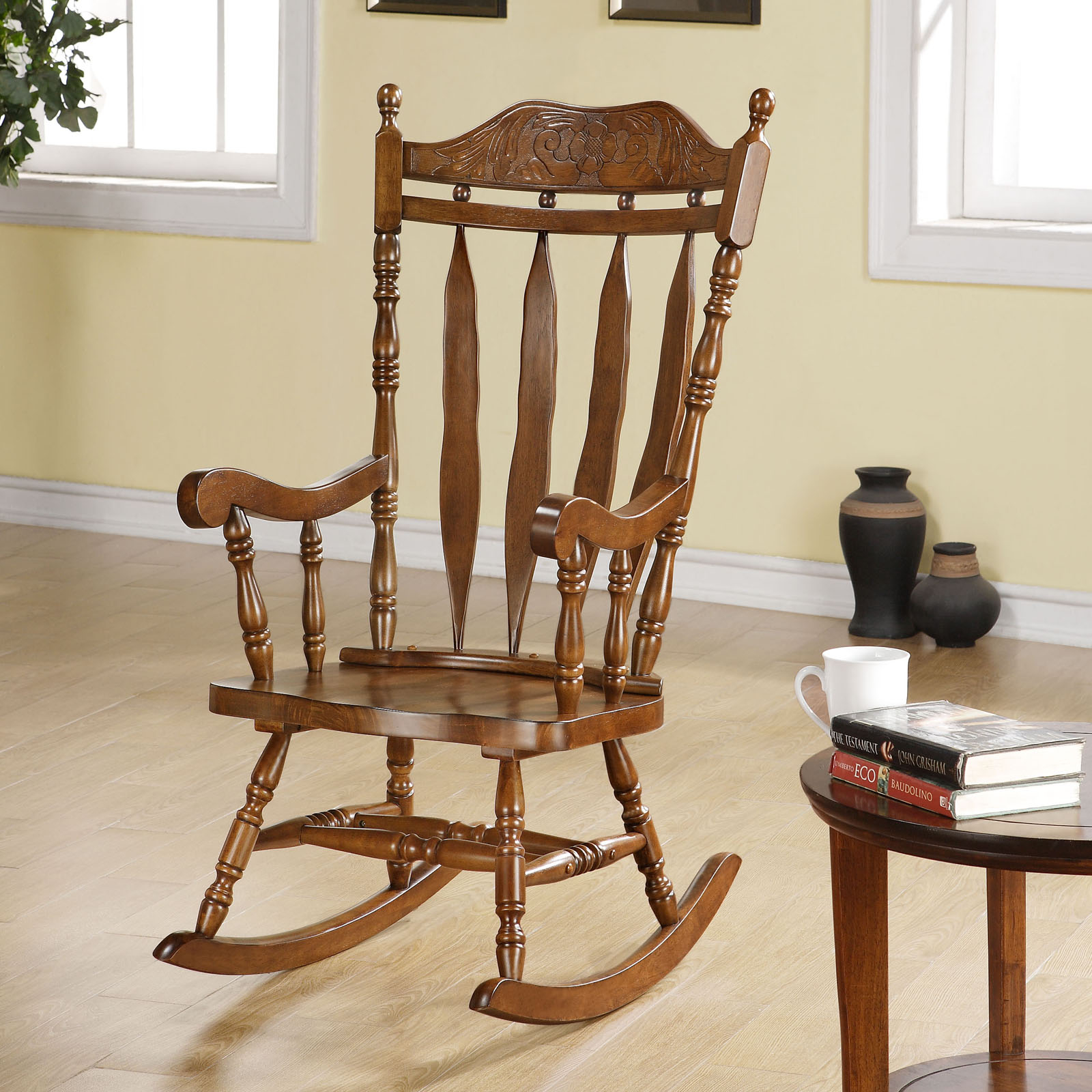History and Origins of Oak Wood Rocking Chairs

Rocking chairs, with their gentle swaying motion and comforting presence, have been a part of human history for centuries. Their origins can be traced back to various cultures around the world, each contributing to the evolution of this iconic piece of furniture. Among the many materials used to craft rocking chairs, oak wood stands out as a material that has been favored for its durability, strength, and aesthetic appeal. This section delves into the fascinating history of oak wood rocking chairs, exploring their historical significance, the evolution of oak wood as a preferred material, and key historical figures or events associated with them.
Historical Significance of Rocking Chairs, Oak wood rocking chair
Rocking chairs have held a significant place in various cultures, often representing comfort, relaxation, and contemplation. In ancient China, for instance, rocking chairs were used by emperors and nobles as a symbol of authority and power. The rocking motion was believed to promote tranquility and balance, aligning with the principles of ancient Chinese philosophy. In Europe, rocking chairs gained popularity during the 18th century, becoming a staple in aristocratic households. They were seen as a symbol of wealth and sophistication, often crafted with intricate carvings and luxurious upholstery. In the United States, rocking chairs became deeply ingrained in American culture, particularly in the Southern states. They were often found on verandas and porches, serving as a gathering place for families and friends to relax and share stories.
The Evolution of Oak Wood as a Preferred Material
Oak wood has long been prized for its durability, strength, and beautiful grain patterns. It is a hard, dense wood that can withstand wear and tear, making it ideal for crafting furniture that will last for generations. In the early days of rocking chair construction, various woods were used, including maple, cherry, and walnut. However, oak wood quickly gained popularity due to its superior strength and resilience. As rocking chairs became more widely used, the demand for oak wood increased, leading to its widespread adoption as the preferred material for crafting these iconic pieces of furniture.
Key Historical Figures and Events
Throughout history, oak wood rocking chairs have been associated with various historical figures and events.
- Thomas Jefferson, the third President of the United States, was known for his love of oak wood furniture, including rocking chairs. He owned several oak wood rocking chairs, which were crafted by skilled artisans of his time.
- Abraham Lincoln, the 16th President of the United States, was often depicted sitting in an oak wood rocking chair, a symbol of his humble and approachable nature.
- The American Civil War saw a surge in the popularity of oak wood rocking chairs, as soldiers used them for relaxation and comfort during their downtime.
- The Victorian Era witnessed a renewed interest in handcrafted furniture, including oak wood rocking chairs. During this period, rocking chairs became increasingly ornate, featuring intricate carvings and detailed designs.
Anecdotes and Stories
The craftsmanship and use of oak wood rocking chairs have given rise to numerous anecdotes and stories that illustrate their enduring appeal.
- One such story tells of a rocking chair that was passed down through generations of a family, each member adding their own personal touch to its design. The chair became a symbol of family history and tradition, representing the enduring bond between generations.
- Another anecdote describes a rocking chair that was used by a famous author as a source of inspiration. The gentle swaying motion of the chair was said to have helped the author relax and clear their mind, leading to the creation of some of their most celebrated works.
Characteristics and Benefits of Oak Wood for Rocking Chairs: Oak Wood Rocking Chair

Oak wood is a popular choice for rocking chairs due to its unique properties that make it durable, strong, and aesthetically pleasing. This wood species possesses characteristics that make it suitable for crafting furniture that can withstand the test of time and provide comfort for generations.
Durability and Strength
Oak wood is renowned for its exceptional durability and strength, making it an ideal material for rocking chairs that are subjected to repeated stress and movement.
- Oak wood is a hardwood, meaning it comes from deciduous trees that lose their leaves in the fall. Hardwoods are known for their density and strength, making them more resistant to wear and tear compared to softwoods.
- Oak wood is also known for its high tensile strength, which means it can withstand significant pulling forces without breaking. This property is crucial for rocking chairs, as the constant rocking motion puts stress on the chair’s frame.
- Oak wood’s resistance to impact and scratches makes it suitable for high-traffic areas and families with children and pets. Its durability ensures that the chair can withstand the rigors of everyday use and retain its structural integrity for years to come.
Longevity
Oak wood is known for its longevity, making it a wise investment for furniture that is intended to last for generations.
- Oak wood is naturally resistant to decay and insect infestation, making it a durable choice for furniture that will be exposed to the elements or stored in humid environments. The wood’s inherent resistance to these factors helps to preserve its structural integrity and extend its lifespan.
- Oak wood is also known for its resistance to moisture, making it a suitable choice for rocking chairs that are placed in areas with high humidity, such as sunrooms or porches. The wood’s ability to withstand moisture helps to prevent warping, cracking, and other forms of damage that can occur due to exposure to water.
- Properly cared for oak wood furniture can last for hundreds of years, becoming heirlooms passed down through generations. Its longevity makes it a valuable investment, not only in terms of its aesthetic appeal but also in its ability to stand the test of time.
Aesthetic Appeal
Oak wood is renowned for its beautiful grain patterns and color variations, which contribute to its aesthetic appeal.
- Oak wood has a distinctive grain pattern that is characterized by its pronounced rays, which create a striking visual effect. The grain patterns can vary depending on the type of oak used, with some species exhibiting more prominent rays than others.
- Oak wood can range in color from light blonde to dark brown, depending on the species and the age of the wood. The color of oak wood can also be enhanced through various finishing techniques, such as staining or waxing, to create a desired aesthetic.
- The natural beauty of oak wood makes it a popular choice for furniture that is intended to be displayed prominently in a home. Its distinctive grain patterns and color variations add a touch of elegance and sophistication to any room.
Comparison to Other Wood Species
Oak wood is often compared to other wood species commonly used for rocking chairs, such as maple, cherry, and walnut.
- Oak wood is generally considered to be more durable and strong than maple, cherry, and walnut. Its higher density and tensile strength make it a better choice for furniture that will be subjected to repeated stress and movement.
- Oak wood is also known for its resistance to scratches and dents, making it a more practical choice for families with children and pets. Its durability ensures that the chair can withstand the rigors of everyday use and retain its structural integrity for years to come.
- While other wood species may offer unique aesthetic qualities, oak wood’s combination of durability, strength, and aesthetic appeal makes it a popular choice for rocking chairs that are intended to last for generations.
Types and Styles of Oak Wood Rocking Chairs

Oak wood rocking chairs come in a wide variety of styles, each with its own unique features and design elements. These styles have evolved over time, influenced by different regions, periods, and makers.
Styles and Key Features of Oak Wood Rocking Chairs
The following table provides an overview of some common styles of oak wood rocking chairs, highlighting their key features and design elements:
| Style | Description | Notable Features | Images (Descriptive) |
|---|---|---|---|
| Mission | Characterized by its simple, functional design with clean lines and a focus on craftsmanship. | Wide, flat arms; low back; often stained in a dark finish. | The Mission style rocking chair typically features a sturdy, rectangular frame with straight lines and a minimalist aesthetic. The arms are wide and flat, providing ample support, and the back is low and gently curved for comfort. The chair is often stained in a dark finish, such as walnut or ebony, to enhance the natural beauty of the oak wood. |
| Windsor | Known for its distinctive spindle back and turned legs. | Spindle back with varying numbers of spindles; often features a saddle seat. | The Windsor style rocking chair is easily recognizable by its distinctive spindle back, which consists of a series of turned wooden spindles that are joined to a curved top rail. The chair typically has a saddle seat, which is slightly concave and provides a comfortable sitting experience. The legs are also turned and often feature a distinctive “bow-leg” design. |
| Colonial | Reflects the style of furniture popular in the American colonies during the 18th century. | Elaborate carvings; cabriole legs; often features a high back. | Colonial style rocking chairs are known for their elegant and intricate designs. They often feature elaborate carvings on the arms, legs, and back, and the legs are typically cabriole, meaning they are curved in an “S” shape. The back is usually high and often features a curved or scrolled top rail. |
| Victorian | Embraces the ornate and elaborate aesthetic of the Victorian era. | Heavy, ornate carvings; often features a high back with a scrolled top rail. | Victorian style rocking chairs are characterized by their heavy, ornate carvings and elaborate designs. They often feature a high back with a scrolled top rail, and the arms and legs are typically heavily carved with intricate patterns. The chairs are often upholstered in rich fabrics and finished in dark, polished wood stains. |
Variations in Design and Craftsmanship
The design and craftsmanship of oak wood rocking chairs have varied across different regions and periods.
- Regional Variations: Rocking chairs made in different parts of the United States often exhibit distinct regional styles. For example, rocking chairs made in New England tend to be more simple and functional, while those made in the South often feature more elaborate carvings and designs.
- Period Styles: The styles of rocking chairs have also evolved over time, reflecting the prevailing design trends of different periods. For example, rocking chairs made in the 19th century often feature ornate carvings and elaborate designs, while those made in the 20th century tend to be more minimalist and streamlined.
Renowned Makers and Designers
Over the years, many renowned makers and designers have created iconic oak wood rocking chairs.
- Samuel Gragg: A renowned American chairmaker from the 18th century, Gragg was known for his high-quality Windsor chairs, including rocking chairs. His chairs are highly sought after by collectors today.
- Gustav Stickley: A prominent figure in the Arts and Crafts movement, Stickley designed furniture that emphasized simplicity, functionality, and craftsmanship. His rocking chairs, made from oak wood, are known for their clean lines and sturdy construction.
- Frank Lloyd Wright: The renowned architect also designed furniture, including rocking chairs. His rocking chairs often feature organic forms and a focus on natural materials.
The classic oak wood rocking chair exudes a timeless charm, offering a comforting haven for relaxation. For a more contemporary touch, consider the target sherpa rocking chair , which combines plush comfort with modern design. Whether you prefer the rustic appeal of oak or the cozy embrace of sherpa, a rocking chair is a delightful addition to any home, inviting moments of peace and tranquility.
Oak wood rocking chairs are known for their durability and classic appeal. If you have an older oak rocking chair that needs a refresh, you can consider reupholstering it. A new fabric can completely transform the look and feel of your chair.
For a comprehensive guide on how to upholster a wooden rocking chair, check out this step-by-step guide: how to upholster a wooden rocking chair. With some patience and the right tools, you can breathe new life into your treasured oak rocking chair.
